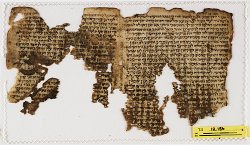Cambridge, UL, T-S 12.186 + Cambridge, UL, T-S 12.187 + Cambridge, UL, T-S 12.188
Origins
Bottom writing: Egypt (?), 6th c. Top writing Egypt (?), 11th c.
Provenance
Found in Genizah of Ben Ezra Synagogue, Fostat, Egypt, and taken to Cambridge by S. Schechter, 1896–97.
Contents
Palimpsest. Bottom writing: Fragments of Psalms in Greek, in a translation thought to be that of Aquila. Extant portions: Ps. 90(89):17– 92(91):10, 96(95):7–12, 98(97):3, 102(101):16–103(102):13. Top writing: Fragments of Yerushalmi, Ta'aniyot and Mashqin.
Codicology
Parchment.
Palaeography
Palimpsest. The bottom text (with which we are concerned) is in a Greek Biblical majuscule hand, in 1 col. Small, fluent hand, with letters close to each other, and with horizontal and oblique strokes curved to the left. No accents, punctuation, or contractions. The tetragrammaton is written in palaeo-Hebrew writing. The top writing is in a square Hebrew hand.
Bibliography
Sokoloff, Michael, Joseph Yahalom , Christian Palimpsests from the Cairo Genizah, Revue de l'histoire des Textes, 8, 1978 , 109-132.
Taylor, Charles, Hebrew–Greek Cairo Genizah Palimpsests from the Taylor-Schechter Collection, Cambridge, 1900.
Tchernetska, Natalie, Greek-Oriental Palimpsests in Cambridge: Problems and Prospects, C. Holmes, J. Waring , Literacy, Education and Manuscript Transmission in Byzantium and Beyond, Leiden, 2002, 243–256.
